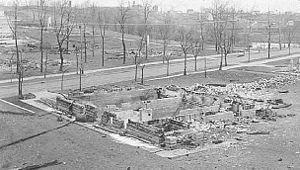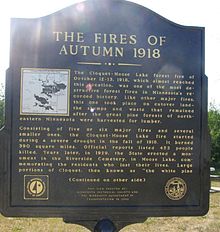- 1918 Cloquet Fire
-
Cloquet Fire of 1918 
Location Carlton County, Minnesota Date October 12, 1918 Burned area 250,000 acres (1,000 km2) Ignition source Drought Land use Mixed use Fatalities 453 The 1918 Cloquet fire was a massive fire in northern Minnesota in October, 1918 caused by sparks on the local railroads and dry conditions. The fire left much of western Carlton County devastated, mostly affecting Moose Lake, Cloquet, and Kettle River. Cloquet was hit the hardest by the fires. It was the worst natural disaster in Minnesota history in terms of the number of lives lost in a single day. In total, 453 lives were lost and 52,000 people were injured or displaced, 38 communities were destroyed, 250,000 acres (1,000 km2) were burned, and $73 million in property damage was suffered. $13 million in Federal aid was disbursed.
Contents
Region overview
Carlton County was known for its logging industry during the early 1900s. Similar to other forest fires, the disaster took place over dry, harvested land which was vulnerable to potential fire destruction. The main workforce employing the majority of the area was the logging industry. The railroad industry, which was established in 1870 was a great boost for the logging industry. In 1874, a large lumber mill was built alongside the lake shore. The mill along the river gathered and floated logs down river, where they would be assembled and sawed for retail. When the logging industry was at its peak, one could walk across the lake due to the amount of logs covering the lake area.
With a new century approaching, open lands in Carlton County were overrun by farmers purchasing land from the mill. The mill’s incentives for sales to farmers were the government grants on the land. With more farmers coming over, the population and activity in Carlton County grew substantially. Stores, lawyers and livestock businesses were established and the economy flourished.
The fire
When asked about the scene at Cloquet after the fact, Albert Michaud, a special Police Officer in Cloquet was quoted by the New York Times,
“ "At 6 o'clock last night, a forest ranger gave warning that unless the wind died down the townspeople would have to flee...The scene at the station was indescribable. There came a rush of wind and the entire town was in flames. The trains pulled out with the fires blazing closely behind them. Women wept and clung to their children, while others cried frantically for their missing ones. The flames licked at the cars. Windows in the coaches were broken by the heat. The engineers and firemen alternately stoked, to give the boilers all the fuel they could stand." ” Early reports of the fire circulated rumors that the fires were intentionally started by "enemy agents", but Cloquet Fire Chief F.J. Longren later confirmed that such rumors were false. The cause of the fire is believed to be from sparks from the railroad tracks that lit the dry timber. Cloquet and its surrounding cities were known for its great deforestation.
Damage and fatalities
Many instances of mass deaths were reported. For example, in Moose Lake, an Associated Press Correspondent reported seeing seventy five bodies piled in a burned building. On a road leading out of Moose Lake, "100 bodies were strewn here and there.", according to New York Times. A relief worker reported that there were thirty bodies piled in a heap in a cellar between Moose Lake and Kettle River.
Among other superstructures of their time, the Duluth Country Club and the Children's Home were both a complete loss. Within Carlton and southern St. Louis Counties the towns of Twig, Rice Lake, Brookston, Brevator, Corona, Adolph, Thompson, Arnold, and Moose Lake were completely destroyed.
Relief operations
The fires left thousands of people homeless. Approximately 4,700 residents of Cloquet sought refuge in Duluth, Minnesota and Superior, Wisconsin. In total, close to 12,000 people were left homeless from neighboring towns. The victims of the inferno were sheltered temporarily in such buildings as hospitals, schools, churches, armories, and private homes. Doctors were brought in from surrounding areas to help the thousands of injured people.
Several organizations and volunteers risked their lives to help save people and property. The Minnesota Infantry National Guard was called in to help in the relief process. At roughly 3:00 pm, Lieutenant Karl A. Franklin and Captain Henry Tourtelotte of the Fourth Regiment of the National Guard were contacted to aid the Rice Lake Road area. After speaking with the Mayor of Cloquet and the Chief of Police Robert McKercher, Tourtelotte headed for Duluth with nine other people to assemble his troops and offer immediate assistance. A couple companies were assigned to the actual extinguishing of the fire itself. Despite their efforts they were not able to extinguish the fire. After torrents of flame battered them down, they changed gear and began to focus on the survivors.
Commanding Officer Roger M. Weaver, of the 3rd Battalion realized the worsening severity of the situation. By about 20 minutes to 6:00 pm the fire chief had called on Weaver and his men who prepared for action. Scores of men were assembled in less than an hour and were then distributed to several hazard sites to aid in the extinguishing the fire.
These efforts of the fire fighters resulted in several important structures being saved. Among these structures was the St. James Catholic Orphanage and the Nopeming Sanatorium. The sanatorium was valued at over $300,000 at the time held close to 200 tuberculosis patients. A party of automobiles broke through walls of flames to save these victims.
Recovery
The recovery of region was area specific due to the nature of the damage dealt. The damage that Duluth sustained had very little threat of impacting the economy, although the fire did destroy several small suburbs, as well as farming communities, but most of Duluth’s economy at the time centered around the transportation and mining, which were left relatively untouched.
The farming industry suffered a large loss. A great deal of livestock was killed and many acres of farmland were torched. Charles Mahnke, who was the Moose Lake member of the relief commission told the farmers "We are going to put you back as well off as you were before.” Relief assistance aided the farming community and with their help the farmers were given a place to stay and the means for rebuilding what they had lost. The Northwestern Telephone Company had phone service restored by Sunday at approximately 7:00 pm. The education of Moose Lake resumed on January 6, 1919 with the immeasurable assistance provided by the Red Cross.
Cloquet had suffered significantly more damage than Duluth and the recovery was much slower and much greater in magnitude. On Sunday, October 20, Cloquet citizens met in Carlton County to talk about what needed to be done. The secondary industries which included: Northwest Paper Company, the Cloquet Tie and Post Company, the Berst-Forster-Dixfield Company toothpick factory, and the Rathborne, Hair and Ridgeway Company box factory. These secondary industries would eventually ascend to the primary industries, but the recovery of the primary industries was much more complex. The Northern Lumber Company, which was responsible for a strong percentage of Cloquet’s economy, had been destroyed. The Northwest Paper Company began production a week after the fire, which gave much needed jobs for the recently “fired” citizens of Cloquet. The Red Cross stepped in and constructed many temporary shelters for the victims’ families of Cloquet. By November 15 there was over 200 shelters built with the help of the Red Cross and other dedicated townspeople. Within a five year span Cloquet had industrialized, rebuilt many of the lost railroads and the citizens moved out of their temporary Red Cross shelters into beautiful new homes.
Memorials
Many memorials have been set up to commemorate the 1918 fire. A twenty-seven foot monument near Duluth memorializes the 453 lives lost. The Moose Lake Area Historical Society annually honors the lives lost at the Soo Line Depot, which in 1995 was opened as a railroad and fire museum. The Soo Line Depot is both a fire and railroad museum that shows the history of the railroads as well as tells the story of the fire.
References
- Carroll, Francis M, and Franklin R. Raiter. The Fires of Autumn: The Cloquet-Moose Lake Disaster of 1918. St. Paul. Minnesota Historical Society Press. 1990.
- "Fires Rages in Minnesota.” The History Channel Website. 2008. 5 February 2008. http://www.history.com/search/.
- Johnson, Lois E. “Commemorating the 80th Anniversary of the Fires of 1918.” The Minnesota History Interpreter. June 1998-6.
- “Moose Lake Minnesota.” The 1918 Fire. 1998. 5 February 2008.
- Panger, Mike. “The USGen Web Project.” Welcome to Carlton County, Minnesota General Info. 15 June 1999. Cloquet. 5 February 2008. http://www.mjpdan.com/genweb/carlton/general.htm.
- “500 Lives Lost in Forest Fires.” New York Times. 14 October 1918.
See also
- Peshtigo Fire of 1871
- Great Hinckley Fire of 1894
- Baudette Fire of 1910
Categories:- Carlton County, Minnesota
- Fires in Minnesota
- Wildfires in Minnesota
- 1918 fires
- 1918 in Minnesota
Wikimedia Foundation. 2010.

